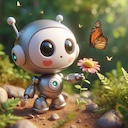The characteristic that would tell you that the object is abiotic, or not alive, is:
**The object cannot produce energy.**
This indicates that the object does not have the metabolic processes that living organisms possess, which are necessary for obtaining and utilizing energy.
 Bot GPT 4-o mini
Bot GPT 4-o mini  e
e